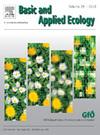Assessment of environmental variables for species distribution modelling: Insight from the mosaic distribution of red- and yellow-bellied toads
IF 3.5
2区 环境科学与生态学
Q2 ECOLOGY
引用次数: 0
Abstract
Species distribution modelling can possibly be improved through the preferential use of explanatory variables that reflect the natural history characteristics of the species being modelled. Red- and yellow-bellied toads (genus Bombina) engage in an intricate mosaic distribution across Europe. Analysing new atlas data on these species’ mutual distribution in Hungary with principal coordinate analysis we identified their differential ecological preferences as forested, hilly and mountainous for B. variegata and open lowland for B. bombina. These locally operating parameters we consider to be good proxies for the essential species difference which resides in breeding in ephemeral puddles at early succession (B. variegata) versus large permanent and later succession ponds (B. bombina). With two-species distribution modelling – in which the presence of one species is contrasted with the presence of the counterpart species – we obtained excellent model fit (AUC) for climate and elevation / land cover datasets alike (AUC=0.98 versus 0.95). For both models fit values dropped upon transference to surrounding countries, yet the latter model kept significantly higher predictive power (AUC=0.91) than the climate model (AUC=0.79). Swapping elevation for ‘hilliness’ as suggested in the literature had a significant negative effect on model performance. We conclude that an informed parameter selection enhances model transferability, therewith improving our understanding of species-habitat associations.

物种分布模型的环境变量评估:从红腹蟾蜍和黄腹蟾蜍的马赛克分布的见解
物种分布建模可以通过优先使用反映被建模物种的自然历史特征的解释变量来改进。红腹蟾蜍和黄腹蟾蜍(bomina属)在整个欧洲以复杂的马赛克分布。利用主坐标分析方法分析了这些物种在匈牙利相互分布的新地图集数据,确定了它们在森林、丘陵和山地的不同生态偏好,以及在开阔低地的不同生态偏好。我们认为,这些局部操作参数可以很好地代表物种的基本差异,这种差异存在于演替早期的短暂水坑(B. variegata)和演替后期的大型永久水坑(B. bombina)中。通过双物种分布模型(其中一个物种的存在与对应物种的存在进行对比),我们获得了气候和海拔/土地覆盖数据集的优秀模型拟合(AUC=0.98对0.95)。两种模式的拟合值在迁移到周边国家后都有所下降,但后者的预测能力(AUC=0.91)明显高于气候模式(AUC=0.79)。如文献中所建议的那样,将海拔替换为“丘陵”对模型性能有显著的负面影响。我们的结论是,知情的参数选择增强了模型的可转移性,从而提高了我们对物种-栖息地关系的理解。
本文章由计算机程序翻译,如有差异,请以英文原文为准。
求助全文
约1分钟内获得全文
求助全文
来源期刊

Basic and Applied Ecology
环境科学-生态学
CiteScore
6.90
自引率
5.30%
发文量
103
审稿时长
10.6 weeks
期刊介绍:
Basic and Applied Ecology provides a forum in which significant advances and ideas can be rapidly communicated to a wide audience. Basic and Applied Ecology publishes original contributions, perspectives and reviews from all areas of basic and applied ecology. Ecologists from all countries are invited to publish ecological research of international interest in its pages. There is no bias with regard to taxon or geographical area.
 求助内容:
求助内容: 应助结果提醒方式:
应助结果提醒方式:


